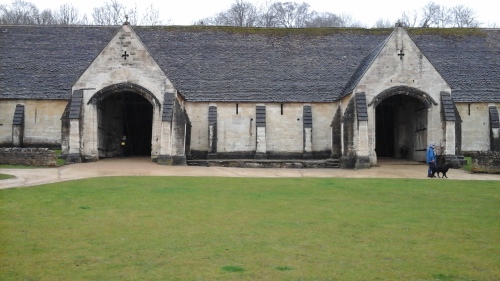
Bradford on Avon Tithe Barn Exterior
On a recent journey to Bath I drove through Bradford-on-Avon, where there is a splendid fourteenth-century tithe barn. Sadly, the weather was dreadful on that day, so the photographs are very dark, but you should be able to get an idea of the size of the barn.
There are about 200 surviving tithe barns in England of varying sizes. English Heritage, who are responsible for it, tells me that this one is 51 metres long or, if you prefer, 55.77 yards.

Bradford on Avon Tithe Barn Exterior
Tithe barns were built to store a parish’s tithes. The tithe was the tenth of the crop given to the church. The object of the tithe was to provide for the parish priest, to pay for the upkeep of the church building, to provide alms for the poor. A proportion was also sent to the local bishop.
As soon as the crop had been reaped a tenth was taken from the field and stored in the barn.

Bradford-on-Avon Tithe Barn Interior
There were three different types of tithes:
- praedial tithes, based on the income from produce;
- mixed tithes, based on income from stock and labour;
- personal tithes, based on income entirely from labour.
Whether you were someone who had your own land and produced your own crops, or earned your living from labour, you paid a tenth of it to the church. Income from woodland was exempt. I haven’t discovered why this should be the case.
Not all parishes had an incumbent rector, i.e. the priest responsible for the parish who lived and worked in it. Somethings this was because the rector was an institution, such as a monastery or a college. This was the case at Bradford-on-Avon, where Shaftesbury Abbey had the living. An absent rector would appoint a deputy, a vicar (from the Latin vicarious, meaning deputy) to look after the parish. The tithe would be shared between the rector and the vicar.
The barn at Bradford-on –Avon belonged to Shaftesbury Abbey, almost 30 miles away, which meant that the parish would have had a vicar.

Bradford on Avon Tithe Barn Cruck Roof
The barns were not only used for storage. They were large, roofed buildings and provided shelter against snow, rain and cold. Cows could be milked inside. Ewes could be kept warm and safe during lambing. On wet days a barn provided a space where labourers could carry out tasks that would normally be done outside.
In theory, the contents of the tithe barns could be used to dispense food to people in times of need.
Sources:
The Companion to Cathedrals and Abbeys – Stephen Friar
Medieval Lives – Terry Jones
The English Manor c1200 – c1500 – Mark Bailey



An impressive building. Now here’s a random question. Would the crosses above the doors be large enough to make entrances/exits for owls?
LikeLiked by 2 people
It is impressive. I should think owls would be able to get in and out.
LikeLiked by 2 people
Another place to visit while in the Cotswolds! Love that area of the UK. Good post, April and I hope you enjoyed your visit.
LikeLiked by 1 person
I did enjoy my visit. It’s my second weekend in Bath in just over two years and I’m starting to find my way around there.
I’ve had a couple of holidays in the Cotswolds generally and it is beautiful.
LikeLiked by 2 people
Oh, that’s good April and yes we love the Cotswolds. Not much of the UK we don’t like come to think of it!
LikeLiked by 1 person
IMPRESSIVE! Clearly, the preservation of tithes was crucial to the medieval Church.
I’ve always wanted to know if tithes also included livestock? Say, a farmer had ten calves born in a year, would he be required to give the tenth animal as a tithe? If so, was the local priest allowed to choose the animal?
Did the farmers bring the tithes to the barn, or did the Church send people out to collect them? I can’t see the Church accepting the worst of the crop.
Surely they’d expect the best? After all, it was “for” God!
Crops were quite diverse. What about wool? Tree fruit? Fish?
If anyone can find out, YOU can, Ms. Mundy! Thank you for sharing your excursion with us!
LikeLiked by 1 person
I don’t think they received livestock as a tithe, but a tithe of their value, possibly when the animal was killed. A few fleeces were probably not much use, so, again, the tithe was probably paid when the wool was sold. I shall keep my eyes open for any further information.
LikeLiked by 1 person
That’s a huge barn, they must have been a big village or very productive.
LikeLiked by 2 people
I doubt the parish would have been very productive. Crop yield in the fourteenth century was a lot lower than it is now and there were some bad harvests in the first twenty years or so of the century. I don’t know how large the parish was, but I suppose that the barn could have been built on such a grand scale simply to impress. As always, I need to read more about these things.
LikeLiked by 2 people
Hi,
I’m interested in tithe barns but am struggling to find academic sources of information on them and how they were used. Is there a chance that you might be able to point me in the direction of some good books and articles?
LikeLike
There are some links to articles about the barn in Bradford-upon-Avon here http://www.english-heritage.org.uk/visit/places/bradford-on-avon-tithe-barn/history/research/.
It’s a bit too specialised for the books I use to have any details, I’m afraid.
LikeLike
Pingback: The Medieval Steward | A Writer's Perspective